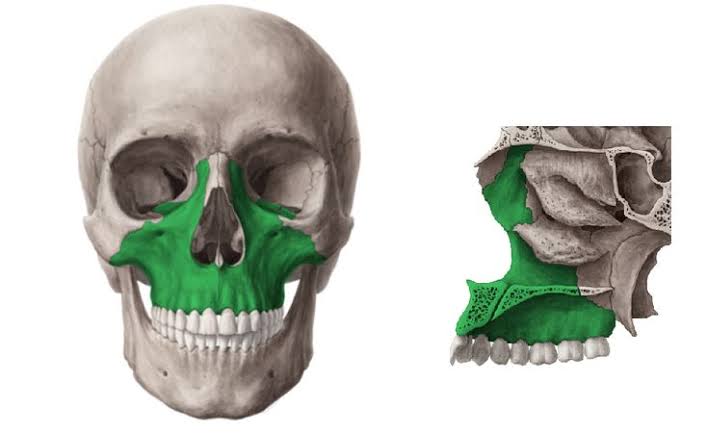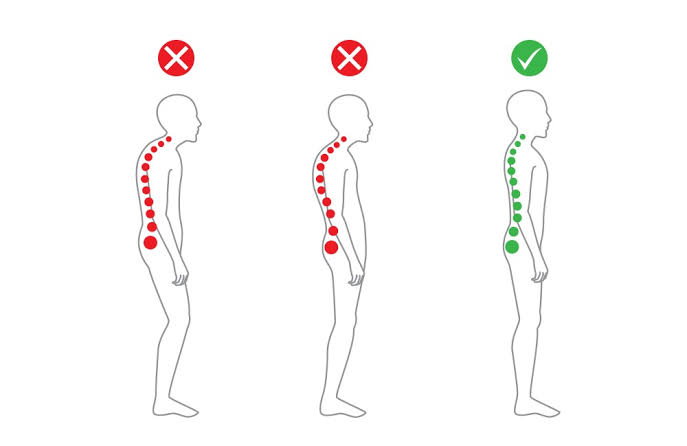1) Do you have good forward growth ?
A good forward growth consists of :
1) Developed maxilla: known as the upper jaw bone, is one of the facial bones that make up the upper part of the human skull. It is a paired bone, meaning that there is one on the left and one on the right side of the face.It contains the sockets for the upper teeth, which support biting and chewing motions.

Receded: Projected:


2) Developed chin: A projected chin is a feature of the human face where the chin is positioned further outward from the lower lip compared to the average proportions.
It is often considered a desirable facial feature, as it can contribute to a more balanced and harmonious facial profile. A projected chin can create a sharper jawline and add definition to the face, which is generally seen as a sign of attractiveness.
It's important to note that facial features can vary greatly from person to person, and what is considered attractive can be influenced by cultural and individual preferences‚ and you can see the difference:

3)Prominent brow ridge: known as supraorbital ridges, refers to the prominent, bony ridges located above each eye socket and below the eyebrows. They are a distinctive feature of the human face, commonly found in both males and females, but more common and pronounced in males.The shape and size of the brow ridges can vary greatly from person to person and can also be influenced by factors such as genetics, age, and gender. In some cases, the prominence of the brow ridges can be a distinguishing feature that adds to an individual's unique facial appearance.

Unprominent brow ridge :

Prominent brow ridge :

4)A well-developed nasal: A well-developed nasal bone plays an important role in the appearance of the face and can contribute to a more balanced and harmonious forward growth.
The nasal bone supports the structure of the nose, which is a central feature of the face. A well-developed nasal bone can create a strong and defined nose that fits in harmoniously with the other facial features.
A well-developed nasal bone can also influence the overall facial symmetry and proportion. A crooked or underdeveloped nasal bone can cause the mid-face region to appear unbalanced or asymmetrical, disrupting the overall balance of the face.


5)Low gonial angle: The gonial angle (also known as the mandibular angle) is the angle formed between the lower border of the mandible (lower jaw) and a line drawn parallel to the ground from the angle of the jaw. A gonial angle of approximately 120 degrees is considered a desirable angle in men, as it creates a defined and masculine jawline. This angle can be used as a measure of facial attractiveness, and a well-defined jaw line can be seen as an attractive feature in men.
For women, a lower gonial angle of around 110 degrees is generally considered an ideal angle

2) how to fix your forward growth
Read carefully
First of all The development and positioning of the maxilla, the upper jaw bone in the face, are primarily influenced by genetic factors and bone structure. While there are certain treatments and procedures that can help enhance facial symmetry and balance, such as orthodontic appliances, facial surgery, or dental procedures, these methods are not typically used to "fix" the maxilla. If you are concerned about the appearance of your maxilla, and I disclaim responsibility for all the methods.
1) Losing weight: One of the most important steps to get defined forward growth and jawline You can follow a low-calorie diet‚ and you can see the difference yourself


2) mewing :
Mewing is a technique that involves the placement of the tongue on the roof of the mouth. The idea behind mewing is that placing the tongue in this position can help to develop facial features, particularly a strong jaw and defined cheeks, as well as potentially improving overall facial symmetry.
Mewing works by applying gentle pressure on the palate (the roof of the mouth) and encouraging the growth and development of the bone structures in the face. Proponents of mewing believe that it can help to correct certain facial asymmetries, such as receding chins or asymmetrical jawlines, and can also lead to an improvement in overall facial aesthetics.

3)How to achieve CCW rotation: People with bad CCW rotation tend to have:
•Higher Gonial angle
•Bad undereye support
•Downgrowth
• Recession

To fix that you need to Chewing gum with your pre-molars will lead to CCW rotations

Chewing with pre-molars will also help loosen the sutures in your maxilla, allowing for actual benefits from mewing to take place
4) Fix your posture:
Poor or slumped posture can have a significant impact on facial development and forward growth. When a person habitually slouches or has poor alignment of the body, it can contribute to facial asymmetry, jaw discrepancies, and a receded facial profile.
Sitting or standing with a slouched position can lead to a downward head tilt, which can cause the lower jaw to develop abnormally and recede backward. This can result in a weaker chin, a lack of projection in the maxilla, and a more pronounced profile.
Maintaining good body alignment and practicing proper posture can help to support normal facial development and contribute to a more forward-project

A good forward growth consists of :
1) Developed maxilla: known as the upper jaw bone, is one of the facial bones that make up the upper part of the human skull. It is a paired bone, meaning that there is one on the left and one on the right side of the face.It contains the sockets for the upper teeth, which support biting and chewing motions.

Receded: Projected:


2) Developed chin: A projected chin is a feature of the human face where the chin is positioned further outward from the lower lip compared to the average proportions.
It is often considered a desirable facial feature, as it can contribute to a more balanced and harmonious facial profile. A projected chin can create a sharper jawline and add definition to the face, which is generally seen as a sign of attractiveness.
It's important to note that facial features can vary greatly from person to person, and what is considered attractive can be influenced by cultural and individual preferences‚ and you can see the difference:

3)Prominent brow ridge: known as supraorbital ridges, refers to the prominent, bony ridges located above each eye socket and below the eyebrows. They are a distinctive feature of the human face, commonly found in both males and females, but more common and pronounced in males.The shape and size of the brow ridges can vary greatly from person to person and can also be influenced by factors such as genetics, age, and gender. In some cases, the prominence of the brow ridges can be a distinguishing feature that adds to an individual's unique facial appearance.

Unprominent brow ridge :

Prominent brow ridge :

4)A well-developed nasal: A well-developed nasal bone plays an important role in the appearance of the face and can contribute to a more balanced and harmonious forward growth.
The nasal bone supports the structure of the nose, which is a central feature of the face. A well-developed nasal bone can create a strong and defined nose that fits in harmoniously with the other facial features.
A well-developed nasal bone can also influence the overall facial symmetry and proportion. A crooked or underdeveloped nasal bone can cause the mid-face region to appear unbalanced or asymmetrical, disrupting the overall balance of the face.


5)Low gonial angle: The gonial angle (also known as the mandibular angle) is the angle formed between the lower border of the mandible (lower jaw) and a line drawn parallel to the ground from the angle of the jaw. A gonial angle of approximately 120 degrees is considered a desirable angle in men, as it creates a defined and masculine jawline. This angle can be used as a measure of facial attractiveness, and a well-defined jaw line can be seen as an attractive feature in men.
For women, a lower gonial angle of around 110 degrees is generally considered an ideal angle

2) how to fix your forward growth
Read carefully
First of all The development and positioning of the maxilla, the upper jaw bone in the face, are primarily influenced by genetic factors and bone structure. While there are certain treatments and procedures that can help enhance facial symmetry and balance, such as orthodontic appliances, facial surgery, or dental procedures, these methods are not typically used to "fix" the maxilla. If you are concerned about the appearance of your maxilla, and I disclaim responsibility for all the methods.
1) Losing weight: One of the most important steps to get defined forward growth and jawline You can follow a low-calorie diet‚ and you can see the difference yourself


2) mewing :
Mewing is a technique that involves the placement of the tongue on the roof of the mouth. The idea behind mewing is that placing the tongue in this position can help to develop facial features, particularly a strong jaw and defined cheeks, as well as potentially improving overall facial symmetry.
Mewing works by applying gentle pressure on the palate (the roof of the mouth) and encouraging the growth and development of the bone structures in the face. Proponents of mewing believe that it can help to correct certain facial asymmetries, such as receding chins or asymmetrical jawlines, and can also lead to an improvement in overall facial aesthetics.

3)How to achieve CCW rotation: People with bad CCW rotation tend to have:
•Higher Gonial angle
•Bad undereye support
•Downgrowth
• Recession

To fix that you need to Chewing gum with your pre-molars will lead to CCW rotations

Chewing with pre-molars will also help loosen the sutures in your maxilla, allowing for actual benefits from mewing to take place
4) Fix your posture:
Poor or slumped posture can have a significant impact on facial development and forward growth. When a person habitually slouches or has poor alignment of the body, it can contribute to facial asymmetry, jaw discrepancies, and a receded facial profile.
Sitting or standing with a slouched position can lead to a downward head tilt, which can cause the lower jaw to develop abnormally and recede backward. This can result in a weaker chin, a lack of projection in the maxilla, and a more pronounced profile.
Maintaining good body alignment and practicing proper posture can help to support normal facial development and contribute to a more forward-project

Attachments
-
 IMG_20241230_041716.jpg47.7 KB · Views: 0
IMG_20241230_041716.jpg47.7 KB · Views: 0 -
 IMG_20241230_041716.jpg47.7 KB · Views: 0
IMG_20241230_041716.jpg47.7 KB · Views: 0 -
 IMG_20241230_044539.jpg502.8 KB · Views: 0
IMG_20241230_044539.jpg502.8 KB · Views: 0 -
 IMG_20241230_020641.jpg70 KB · Views: 0
IMG_20241230_020641.jpg70 KB · Views: 0 -
 IMG_20241230_025615.jpg15.8 KB · Views: 0
IMG_20241230_025615.jpg15.8 KB · Views: 0 -
 IMG_20241230_030307.jpg29.7 KB · Views: 0
IMG_20241230_030307.jpg29.7 KB · Views: 0 -
 IMG_20241230_030307.jpg29.7 KB · Views: 0
IMG_20241230_030307.jpg29.7 KB · Views: 0 -
 images (2) (28).jpeg5.5 KB · Views: 0
images (2) (28).jpeg5.5 KB · Views: 0 -
 images (2) (27).jpeg4.9 KB · Views: 0
images (2) (27).jpeg4.9 KB · Views: 0


